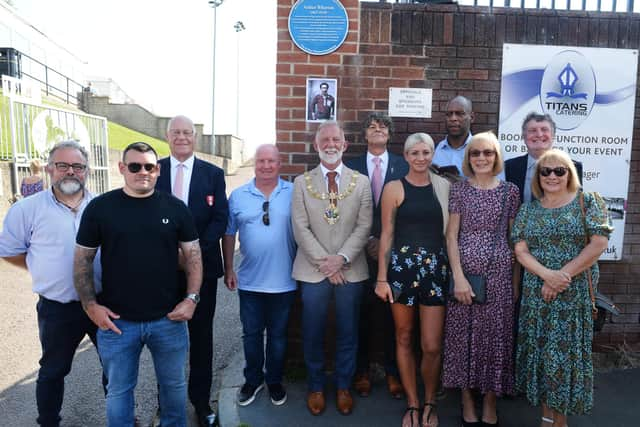Arthur Wharton will never be forgotten


Finally, the achievements of Arthur Wharton – the first black professional footballer – have been recognised in Rotherham with the unveiling of a blue plaque outside the ground where he made his mark.
It’s an extraordinary story with an unlikely beginning in Jamestown in the Ghanaian capital of Accra in 1865. It moves to Darlington, then Rotherham and quietly extends its reach until it takes in the world.
Advertisement
Hide AdAdvertisement
Hide AdMaybe that final part is the next instalment, but the unveiling of a blue plaque in tribute to Arthur means this remarkable person will never be forgotten.


He was already the world’s fastest man and had played cricket and rugby professionally, as well as being able to throw a cricket ball over 100 yards, when he walked out at Clifton Lane to make his debut for Rotherham Town in 1889 – and as a pro when the club joined the Football League in 1893.
We know the last bit because former Advertiser sports editor Les Payne had, as always, done his research, locating the matchday programme at an auction, spotting Arthur’s name and discovering the game against Walsall was his first of the season.
The unveiling of the plaque 134 years to the day – September 7 – since his first appearance for Town, took place outside the Clifton Lane gates and was watched by civic dignitaries, members of Arthur’s family, representatives of Rotherham United and former footballers including David Speedie and Ken Monkou, the first black footballer to win Chelsea’s player of the year award in 1990.
Advertisement
Hide AdAdvertisement
Hide AdShaun Campbell, founder of the Darlington-based Arthur Wharton Foundation, conducted the ceremony with Mr Monkou and said the minute’s applause for Arthur – who moved to England to train as a missionary in Darlington – at the Rotherham United versus Hull City game last season was a poignant and pivotal moment.


Mr Campbell, who has involved soul singer Stevie Wonder and Fifa president Sepp Blatter in the Arthur Wharton story, said: “Here we are in Rotherham unveiling a blue plaque 134 years to the day since Arthur played his first game for the club. We have always known this day would come.”
He said his own experience of growing up in Leeds in the 1970s as a black child with a white mother had been difficult with the National Front regularly campaigning in the city, and change since then had been slow: “There is a 16ft statue of Arthur at the National Football Centre in St George’s Park in Burton-on-Trent, it is the tallest statue of a footballer in England and anyone playing for England walks past it and knows that is Arthur Wharton, yet there are still so few black coaches in football here and that has to change.
“Think about the adversity Arthur must have felt and put that into perspective – Rotherham has the greatest all-round sportsman the world has ever seen. This town can see so much more footfall than it does now because of Arthur. It is your town and you have the world’s greatest ever sporting icon. Do everything you can to make his name stand out because the world will envy that.”
Advertisement
Hide AdAdvertisement
Hide AdHe pointed out that everyone was one step away from being part of a group who had been discriminated against either through race, disability or sex – women’s football was banned after the First World War despite, or because of, games pulling in crowds of 50-60,000. “Now look what is happening. Opportunities make things happen.”
Rotherham District Civic Society treasurer Bernard Fletcher told the roadside gathering: “This is the 26th blue plaque the civic society has erected around Rotherham and is very important as the first to acknowledge the contribution of a black person to the town’s history. Arthur was a trailblazer.
“Arthur Wharton played for the club here at this historic Clifton Lane sports ground during a period of social unrest during the 1890s. There is no doubt that he experienced bigotry and racial spite in those days.
“However, he was a strong character, who managed to overcome these issues and was successful in life. He excelled at football, cricket, rugby, cycling and athletics. In 1886 he won the 100 yards dash in the AAA championships in a world record time of ten seconds which was a magnificent achievement.”
Advertisement
Hide AdAdvertisement
Hide AdRotherham councillor Michael Bennett-Sylvester, who led the campaign locally for the plaque, thanked everyone involved in making the plan come to fruition, including the Advertiser’s Gareth Dennison for his work on local history features, and the civic society, adding: “I love the way you are telling our story nationally and locally, where young people in deprived neighbourhoods can walk past and see a blue plaque and think: ‘Why can’t that be me? That person looks like me’.”
Les Payne said when he checked the date of the football programme he picked up – Rotherham United paid £400 for it and it is now on display in the club’s reception – he carried out some research and realised the match against Walsall in 1893 was Arthur’s first game as a Football League professional for Town, having signed for the club four years previous.
“It struck me pretty quickly that that was the first appearance of Arthur Wharton in the league and therefore the first appearance of any black player in the Football League. I thought: ‘That can stay in Rotherham.’
“Arthur played here and at Clifton Grove and if you go there you will still see the original entrance to the ground. We will always have a bit of Arthur Wharton in Rotherham.”Former Chelsea and Liverpool striker David Speedie said he had stopped at Edlington Cemetery on the way to Clifton Lane to lay flowers at Arthur’s grave.